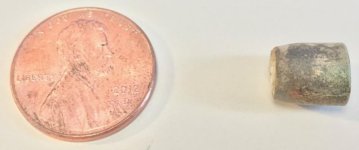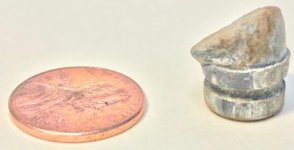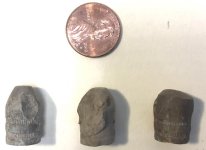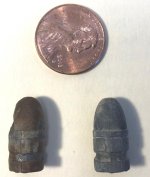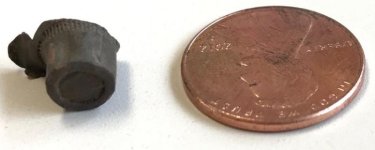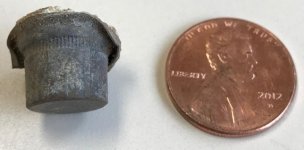I am an archaeologist working at a WWI training camp located in the California Bay Area. This camp was used during WWI and saw limited use during WWII and by sport/civilian shooters. So, most of these bullets should be U.S.-made rounds, either military or commercial, dating as early as the late 1800s to the present day.
I would like to know the caliber and approximate date range for each bullet. I realize that ID-ing/dating fragments of bullets is very difficult, but I'm just trying to get as close as possible to an estimated caliber and date. Let me know if you need additional specs or pics.
Photos of each bullet are posted at the end of this thread in sequential order (left to right/top to bottom), but go here for additional photos:
https://drive.google.com/open?id=0B90rGWsqo4rFMkhTdEZqM2g0Wkk
1. Bullet: lead, round-nose, flat base (small hole in center), two thin smooth grooves around base
-Diameter = .348-.355" (~9mm); length = .490"; weight = 112 grs.
-Guess = .380 ACP (9mm Browning Short), .380 Extra Short, 9mm pistol round?
-Photos: 542 & 544
2. Bullet frag: non-magnetic (probably cupro-nickel or gilding metal) jacket, recessed and enclosed base, partitioned/semi-jacket nose?
-Diameter = .307-.312 (~7.90mm), length = .365+", 60+grs.
-Guess = .32 ACP, .32 S&W, .30 Carbine M1?
-Photos: 547, 549, 551
3. Bullet: lead, round-nose(?), flat base, two smooth groves around base
-Diameter (base band) = .448-.456” (~11.5mm); length = .584”; weight = 209 grs.
-Guess: .45 revolver of some kind?
-Photos: 574-575
4. Bullets (3) that seem to be same caliber: lead, flat-nose, recessed base, two knurled groves around base
-Diameter = .436-.453” (~11.3mm); length = .725”; weight = 239 grs.
-Guess: .45 Colt / .45 Colt Government / .45 Colt Model 1909 / .45 S&W (Schofield)?
-Photos: 578 & 581
5. Bullets (2) of the same caliber: lead, round-nose, flat base, one wide and one narrow smooth grooves with three bands around base
-Diameter = .350-.356” (~8.95mm); length = .718”; weight = 149 grs.
-Guess: .38 S&W / .38 Long or Short Colt / .38 Special?
-Photos: 583 & 585
6. Bullet jacket fragment: non-magnetic (probably cupro-nickel or gilding metal), recessed and enclosed base (two-stepped circular depression), one knurled cannelure located .692" from base, band just below cannelure groove .125" wide
-Diameter = .300-.313” (~7.75mm); length = 1.018+”; weight = 57+grs.
-Guess: .303 British Mark VI or VII
-Photos: 586 & 589
7. Bullet jacket fragment: non-magnetic (probably cupro-nickel or gilding metal), recessed and enclosed base, one knurled cannelure located .224" from base
-Diameter = .25-.26" (~6.45mm)
-Guess: .25 ACP?
-Photos: 602 & 603
8. Bullet fragment: non-magnetic (curpo-nickel/gilding metal) jacket, lead core, flat enclosed base, one knurled cannelure located .285" from base; bullet appears to taper slightly down to base, but this may be due to expansion from impact
-Diameter = .419-.427 (~10.75mm) around base; .438" (~11mm) just below cannelure groove
-Guess: 11mm machine gun round?, .44-40 round?, .44 revolver?, .45 revolver?
-Photos: 605
I would like to know the caliber and approximate date range for each bullet. I realize that ID-ing/dating fragments of bullets is very difficult, but I'm just trying to get as close as possible to an estimated caliber and date. Let me know if you need additional specs or pics.
Photos of each bullet are posted at the end of this thread in sequential order (left to right/top to bottom), but go here for additional photos:
https://drive.google.com/open?id=0B90rGWsqo4rFMkhTdEZqM2g0Wkk
1. Bullet: lead, round-nose, flat base (small hole in center), two thin smooth grooves around base
-Diameter = .348-.355" (~9mm); length = .490"; weight = 112 grs.
-Guess = .380 ACP (9mm Browning Short), .380 Extra Short, 9mm pistol round?
-Photos: 542 & 544
2. Bullet frag: non-magnetic (probably cupro-nickel or gilding metal) jacket, recessed and enclosed base, partitioned/semi-jacket nose?
-Diameter = .307-.312 (~7.90mm), length = .365+", 60+grs.
-Guess = .32 ACP, .32 S&W, .30 Carbine M1?
-Photos: 547, 549, 551
3. Bullet: lead, round-nose(?), flat base, two smooth groves around base
-Diameter (base band) = .448-.456” (~11.5mm); length = .584”; weight = 209 grs.
-Guess: .45 revolver of some kind?
-Photos: 574-575
4. Bullets (3) that seem to be same caliber: lead, flat-nose, recessed base, two knurled groves around base
-Diameter = .436-.453” (~11.3mm); length = .725”; weight = 239 grs.
-Guess: .45 Colt / .45 Colt Government / .45 Colt Model 1909 / .45 S&W (Schofield)?
-Photos: 578 & 581
5. Bullets (2) of the same caliber: lead, round-nose, flat base, one wide and one narrow smooth grooves with three bands around base
-Diameter = .350-.356” (~8.95mm); length = .718”; weight = 149 grs.
-Guess: .38 S&W / .38 Long or Short Colt / .38 Special?
-Photos: 583 & 585
6. Bullet jacket fragment: non-magnetic (probably cupro-nickel or gilding metal), recessed and enclosed base (two-stepped circular depression), one knurled cannelure located .692" from base, band just below cannelure groove .125" wide
-Diameter = .300-.313” (~7.75mm); length = 1.018+”; weight = 57+grs.
-Guess: .303 British Mark VI or VII
-Photos: 586 & 589
7. Bullet jacket fragment: non-magnetic (probably cupro-nickel or gilding metal), recessed and enclosed base, one knurled cannelure located .224" from base
-Diameter = .25-.26" (~6.45mm)
-Guess: .25 ACP?
-Photos: 602 & 603
8. Bullet fragment: non-magnetic (curpo-nickel/gilding metal) jacket, lead core, flat enclosed base, one knurled cannelure located .285" from base; bullet appears to taper slightly down to base, but this may be due to expansion from impact
-Diameter = .419-.427 (~10.75mm) around base; .438" (~11mm) just below cannelure groove
-Guess: 11mm machine gun round?, .44-40 round?, .44 revolver?, .45 revolver?
-Photos: 605
Attachments
Last edited:



